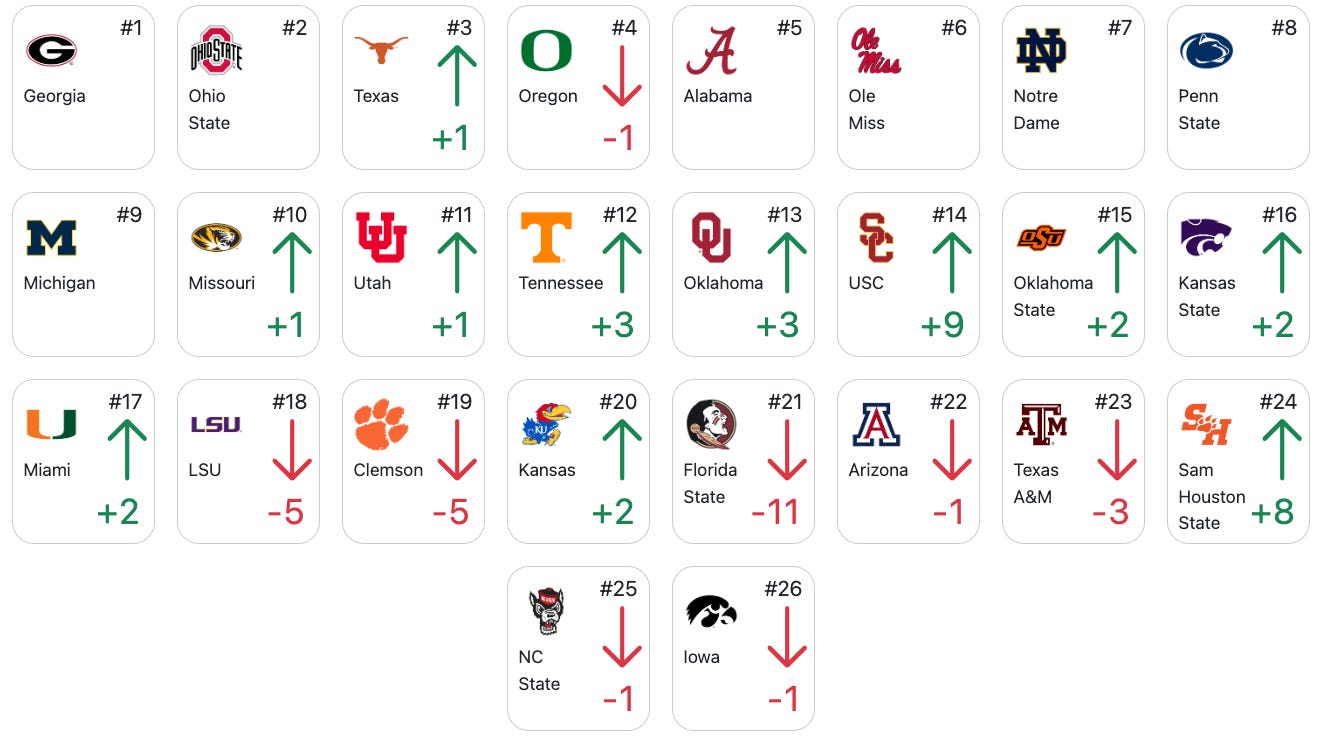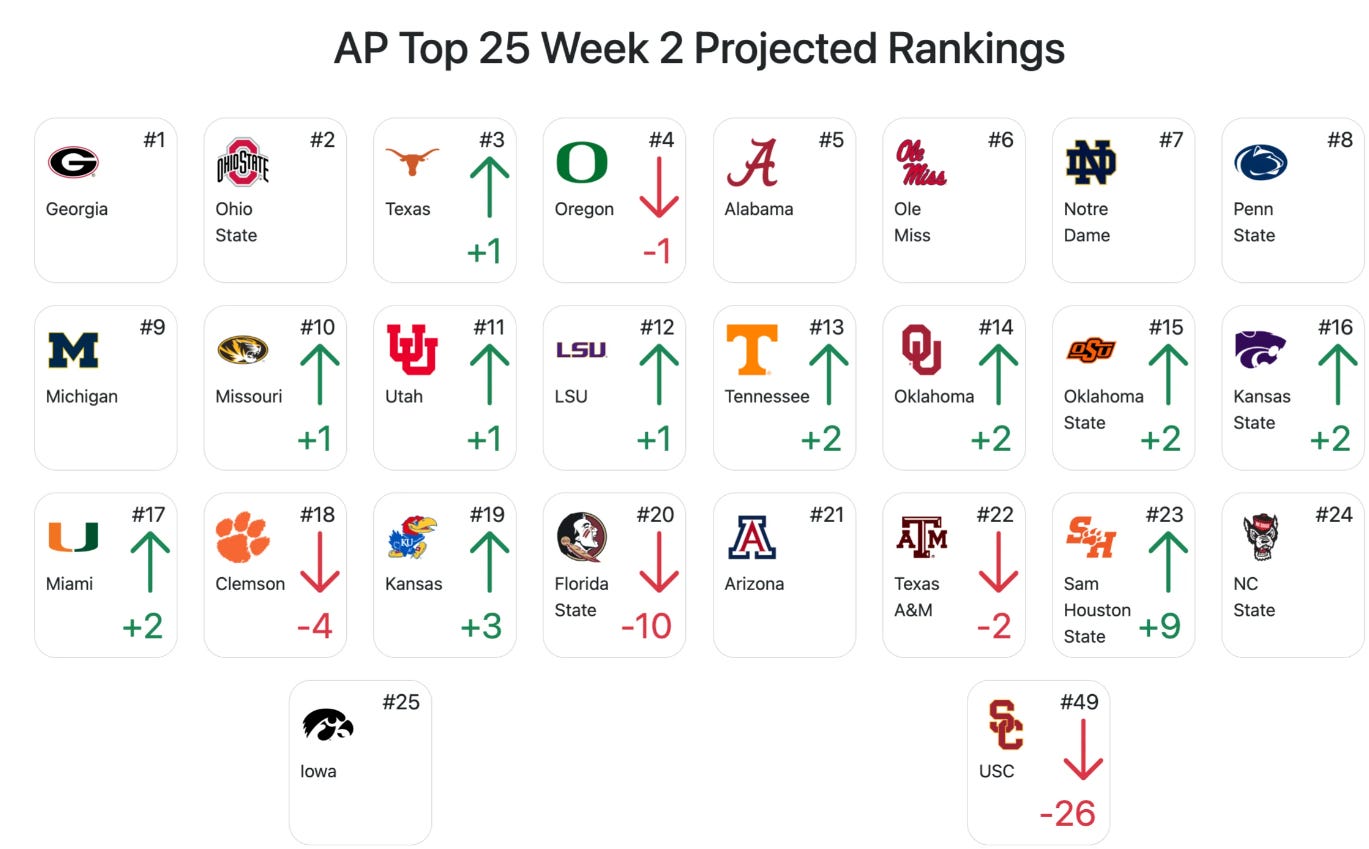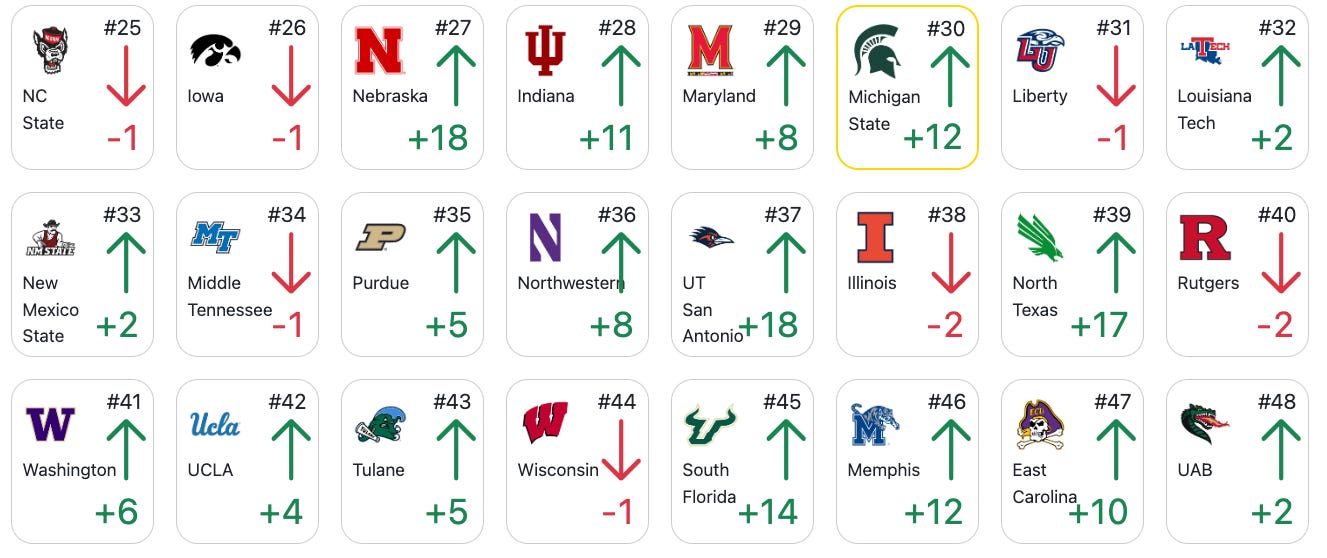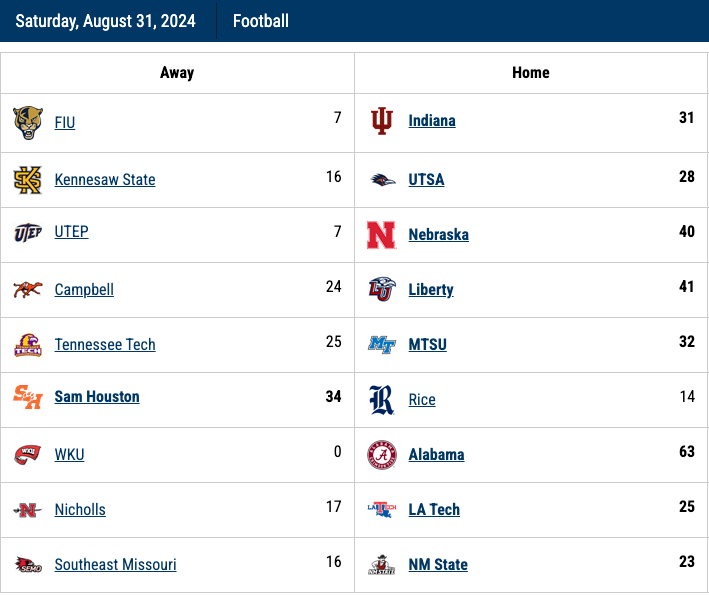Week 1 Recap and New Projected Rankings
Going through the next projected Top 25, and answering two common questions throughout the weekend
It felt good to have another Saturday (and Sunday) filled with football. Today we will dive into how the rankings are looking, and two frequently asked questions about Rankings Right Now.
Stability Up Front
Here are the top 25 projected rankings for the next release of the AP poll.
From the machine learning models that create the predictions, it appears there is almost no movement in the top 10. The only predicted changes are:
Texas and Oregon flip due to Texas beating CSU in a blowout and Oregon struggling to get to the finish line against Idaho
Mizzou moves into the top 10 as Florida State is the only team in the top 10 who actually lost a game
Most of these early season games are against cupcakes for top programs. Saturday had a lot of games with no real competition in them. Even though a team like Notre Dame took on a tough opponent in a tough environment, the teams above them (minus Oregon) destroyed their opponents. The algorithm doesn’t think an early season tough win is greater than a 75-0 beatdown of a school you've never heard of.
When the next AP poll comes out, I believe the top 17 or 18 will be pretty close, with a few misses coming of the last 10 teams or so. Based on how Week 2 predictions have gone in years past, there are teams that will pop into the bottom of the rankings that are not on the model’s radar yet, but the AP Poll will like.
But They Haven’t Played Yet
Prior to the USC vs LSU game last night, I posted this projection to a bunch of college football boards on Reddit. It was great to see some reactions, people torching my predictions on Sam Houston State (more on that in a minute), and some fun feedback.
However, one thing that was confusing people looking at the poll for the first time.
“How could USC drop so far in the rankings if they haven’t even played yet?”
Rankings Right Now is trying to solve one major question - Instead of waiting until all of the games have finished, if you could ask the AP Poll (or College Football Selection Committee Later in the year) to release a poll RIGHT NOW, how would it look?
In order for this to happen, Rankings Right Now does the following:
For completed games, take the final score (duh)
For games that are in progress, take the current score and treat it like the final score
For games that have yet to be played, take the projected score based on Las Vegas sport books
Yesterday, LSU was favored to beat USC. Rankings Right Now uses that information and infers if you were to poll the AP panelists before that game happened, they would assume LSU would win that game and come up with the conclusion USC would fall out of the top 25. This seems a little confusing at first, but we as fans also do the same thing throughout the day. We assume Oregon will win by 100 and there won’t be anything left to change, but as the game begins to shift and people want to know RIGHT NOW what might happen, Rankings Right Now lets us peek into a hypothetical world.
Yesterday I probably definitely jumped the gun with this post. Lesson learned! This shouldn’t be too much of an issue moving forward since almost all games in the future will be completed by the end of the day on Saturdays, with the NFL taking over the main focus on Sundays.
Sam Houston State?
I know, I know. It makes absolutely no sense to have that prediction there. So how did it actually get there in the first place? In order to discuss this, we need to take a quick step back.
Week 2 is by far the hardest week to predict. Why? It is because we have no in-season context. We are running off of the AP Top 25 as our only source of truth, and that provides us with 25 out of 130 teams. So how does the algorithm know who’s sitting at 26 to start the year? That is where historical data comes into play.
These models (another word for algorithm for those who don’t know) are trained on data from previous seasons. The goal for preseason rankings is to place conferences into structured tiers. The algorithm should want teams who start unranked to be closely ranked near #25 if they belong to a conference who typically sees new teams enter the top 25 early in the season that start off unranked.
The two screenshots below show the number of teams who were ranked for the first time each week in the AP poll, for each conference. For example, in Week 5 of the 2023 season, there was 1 Mountain West team, 1 SEC team, and 1 Big 12 team who entered into the AP Top 25 for the first time.
These are two seasons of examples, but a lot more data goes into the model. In 2022, the Big Ten had multiple weeks after Week 1 where new teams were ranked in the AP Poll for the first time. If we check out the current projected rankings for slots #25-#48, we see a lot of Big Ten teams who are included in that mix; however, we also see a lot of Conference USA!
Sam Houston State belongs to Conference USA! This is interesting because according to the two charts I included earlier, Conference USA has very little inclusion of new ranked teams early in the season. This means it might have to do with one other thing. Let’s look at the 2024 Week 1 schedule for teams in Conference USA.
What is relevant about this? Notice how Conference USA plays some non-conference games against Power 5 conferences. These games can be a propellant for these other conferences to get into the top 25, inferring the Rankings Right Now algorithm values this conference. They typically lose their games against the Power 5 opponents, but when there is a “big” win - like Sam Houston State winning by 20 on the road - it’s going to give them a boost right up to the front of the pack.
This is NOISE. Ignore it. As the season goes on, everything will start to settle into place and there will be validity to why a team is breaking into the top 25. Right now, we’re playing darts in a dark cave when it comes to teams outside the top 25.
What’s Next?
We’ll check back in when the AP Poll gets its new rankings! We can compare on what makes sense, what is surprising, and how the predictive Rankings Right Now model stacks up to it.
Fun first week!









